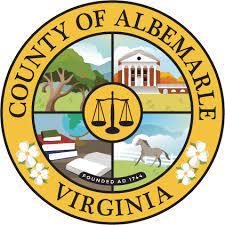Albemarle County is 280 years old and will celebrate a tricentennial in 2044. That year is also what planners are targeting as work continues on an update of the Comprehensive Plan.
One item on a long list of stories I want to step up coverage on is the update of the plan. Let’s go back in time now to March 20, 2024 when the Board of Supervisors held the first of two work sessions on the AC44 process. That’s the name for the Comprehensive Plan update. Tori Kanellopoulos is a principal planner in the county’s Department of Community Development. (view materials for the March 20, 2024 presentation)
“There are eight plan chapters, each of which have goals, objectives, and actions,” Kanellopoulos said. “Goals are where we want to go. Objectives are outcomes or targets to help us get there. And the actions are the steps to make the plan happen.”
The Comprehensive Plan is being updated in a five-phase process and planners are at the end of phase 2 which is to create the new goals and objectives. Phase 3 will see the creation of the action steps followed by prioritization as well as the development of metrics intended to gauge progress.
A big question that undergirds the whole discussion is whether Albemarle has enough room in its current development area to support anticipated population growth. The Weldon Cooper Center for Public Service at the University of Virginia projects the number of people who live in Albemarle will increase from the 2023 estimate of 115,676 individuals to 124,016 in 2030, 138,523 in 2040, and 155,102 by 2050.

Since 1980, the Comprehensive Plan has divided Albemarle into one of two land use categor ies. There’s a development area of roughly five percent of the county’s 726 square miles, and a rural area where county rules are strict about what can be built and what uses can occur.
“Efficient use of development area land is a topic we’ll be asking for the Board’s direction on today,” Kanellopoulos said. “We’ve also heard that for the rural area we should explore opportunities for small-scale and community serving uses and services and opportunities for community resilience hubs.”

Those hubs would be intended to be gathering and distribution points in case of a disaster.
The county is also looking to review whether more uses should be allowed at the Shadwell and Yancey Mills interchanges on Interstate 64. Kanellopoulos said future discussions would take place through the development of small-area plans. She also shared some of the current feedback on priorities for the rural area.
“Many of these priorities are consistent with the current Comprehensive Plan with an overall emphasis on protecting the natural environment and having usable land for agriculture and forestry in the rural area,” Kanellopoulos said. “Implementation would be done primarily through future small area planning efforts for those areas.”
Kanellopoulos said about 45 percent of Albemarle residents live in the rural area. Should there be more services in those areas like medical offices? As a way to head into that direction, there is a draft goal 4.
“Albemarle County will proactively plan for unique locations in the Rural Area with established land-use patterns, zoning, and existing development that are inconsistent with Rural Area goals, including locations where development has already occurred that does not conform with Rural Area goals, locations with zoning other than Rural Area that are adjacent to the Development Areas, and the rural interstate interchanges.”
“Implementation would be primarily be done through future small area planning efforts for those areas,” Kanellopoulos said.
One new objective would be to create a new “rural area land use plan” that would try to get move away from a “one-size fits all” approach for those properties.
Supervisor Diantha McKeel’s Jack Jouett District is the least rural of the six political subdivisions. She said she supported small-scale commercial uses outside of the rural area and supported small area plans for areas designated as “Crossroads Communities.” (learn more on Engage Albemarle)
“I am in favor of them in theory but the devil is always in the details, right?” McKeel said.
McKeel also noted that there has been initial feedback regarding adding bike and pedestrian facilities on rural roads.
“I’m just not sure exactly how that would play out realistically with our limited financial resources,” McKeel said. “Realistically, we are struggling in the development area for transportation alternatives.”
Kanellopoulos said improvements would not necessarily be large scale but could involve wider shoulders or could be building specific trails.
McKeel was also skeptical about large expansions of transit into the rural area but suggested that is further work that the proposed Regional Transit Authority might undertake.
“There is no way we can afford to put a robust transit system in 726 square miles,” McKeel said.
Supervisor Ned Gallaway of the Rio District agreed with McKeel that spending money on multimodal transportation in the rural area was a non-starter.
“We’re not putting walking, biking and transit infrastructure in the rural area,” Gallaway said. “So I’m not going to be supportive of that.”
“There’s no way,” said Supervisor Ann Mallek
“There’s no way, McKeel chimed in again.
Gallaway also supported Crossroads Communities but favored leaving up the direction for each of them to the people who live around them. He did support the Albemarle’s development of community resilience hubs in the rural areas.
“I feel like we should somehow provide places for folks to go when power is out especially during either extreme heat or extreme cold times,” Gallaway said. “Whether or not those have to be in the Crossroad Communities, I don’t know, but the county definitely has a responsibility to provide that.”
One of the questions to Supervisors was whether they would support allowing more uses in the rural area if they were controlled by a special use permit. Gallaway said he would be open to the idea. Supervisor Ann Mallek suggested there be clear guidelines.
“It depends because a large fuel station and convenience center is different than an artisan furniture maker as far as its impact,” Mallek said.
Mallek said Earlysville may not be considered a Crossroads Community but it is a village with more than just homes. But she said many businesses that may be desired by planners may not be viable.
“Five churches, a post office, a doctor’s office which went out of business due to lack of interest,” Mallek said. “Two auto repair shops. A thrift store. Its grocery store went out of business when the bridge at Advance Mills was closed and all of the Greene County people had to find another way and then Harris Teeter opened in Hollymead and that was the end of the grocery store.”
Mallek said people who live in the country do not expect to have many businesses close by and the whole point of the Comprehensive Plan is to allocate Albemarle’s resources to areas where there is infrastructure.
“I would hope that our Comprehensive Plan would not be making promises about all sorts of different things that have very little chance of ever coming true,” Mallek said.
Mallek also suggested language that any community resiliency hubs would be in existing structures rather than in new buildings.
Mallek also had a suggestion that Albemarle consider creating an agricultural zoning district, something she said hasn’t existed since 1980 when the county downzoned to reflect Comprehensive Plan, creating the Rural Area zoning category that became a one-size-fits-all approach for the overwhelming majority of Albemarle’s 726 square miles.
“And what that meant is that it became a residential almost de facto despite tremendous protest from people in the rural area that said the first use, the primary use should be agriculture and forestry and not ag and forestry and residential and little commercial uses or whatever,” Mallek said.
Mallek also warned about putting anything in the Comprehensive Plan that would take away resources from the development area such as traffic calming efforts.
“We have a terrible time accomplishing such things,” Mallek said.
Supervisor Mike Pruitt of the Scottsville District said he liked the direction the Comprehensive Plan is heading with regard to the rural area.
“I think it’s important that we think of the rural area as a place with real texture, right?” Pruitt said. “There’s a place with a diversity of actual uses, a diversity of living, and actual diverse economic activity that goes on there.”
Pruitt said efforts to preserve land benefit private individuals more than the rest of the public. He said the Comprehensive Plan should focus on placemaking in the rural area to allow more people to enjoy it.
“A place in the rural area as someone who does not currently live in the rural area that I frequently visit and enjoy is the Dick Woods Road Miller School parking area,” Pruitt said. “It’s a very popular cross country track.”
To Pruitt, placemaking would involve making sure it is safe to access such areas. He also said he would support small-scale restaurants in Crossroads Communities to create spaces for people and their families to go.
Pruitt also said the best way for landowners to make money off rural land now is through luxury housing, something he said should be discouraged by allowing pockets of smaller footprint structures.
“Is there a way to legalize and make by-right more affordable units and more affordable design types and patterns of living in the [rural] area?” Pruitt asked.
Pruitt said he understands such a policy would have to be done in a way to discourage sprawl and that the county should look and see what similar communities are doing across the country.
More from the AC44 process in the near future as I go through various meetings. Also discussed at the March 20 meeting is land use and transportation in the development areas.
The Community Facilities chapter was discussed on April 3 which includes the county’s growth management policy.

Before you go: The time to write and research of this article is covered by paid subscribers to Charlottesville Community Engagement. In fact, this particular installment is from the April 15, 2024 edition of the newsletter. To ensure this research can be sustained, please consider becoming a paid subscriber or contributing monthly through Patreon.













